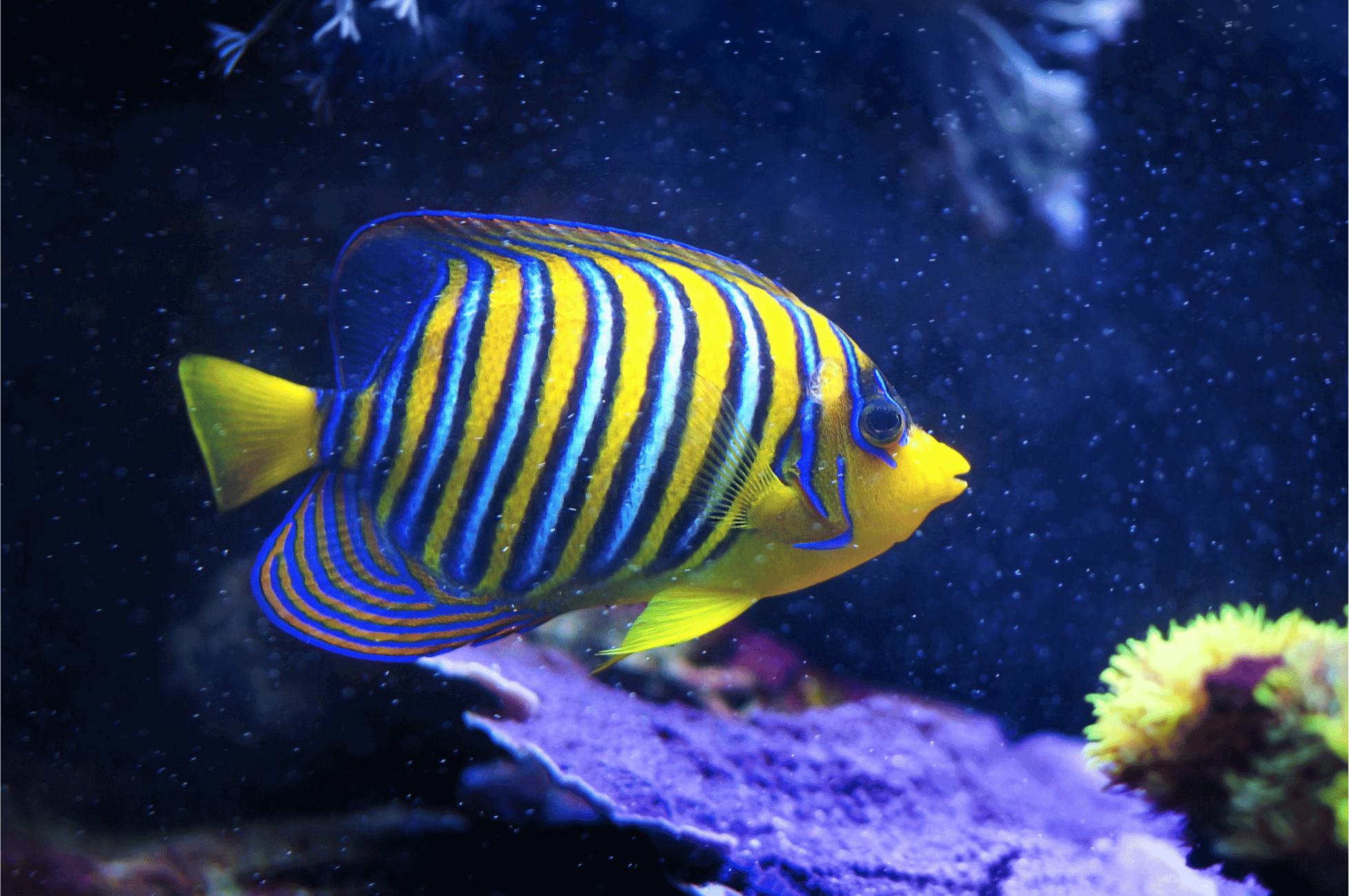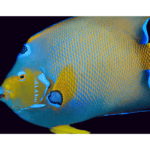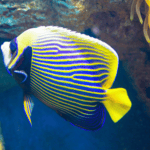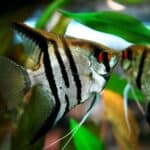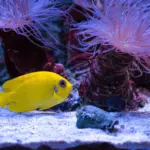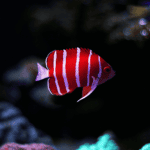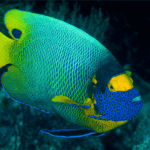Saltwater angelfish are a captivating group of marine fish that are popular among aquarists, both novice and experienced, for their striking colors and elegant shapes. Known for their adaptability and their extraordinary beauty, these fish typically inhabit the warm waters of coral reefs in the Indian, Pacific, and Atlantic Oceans. Their vibrant appearance, along with their unique behaviors and sociability, make them a stunning addition to any reef aquarium.
Notwithstanding their beauty and charm, saltwater angelfish require special attention in terms of diet, tank environment, and compatibility with other fish species. The natural habitat of these delicate creatures is crowded with diverse coral and plant species, and mimicking this environment is crucial for their well-being. Additionally, proper water quality and chemistry should be maintained to ensure the optimum health and vitality of the saltwater angelfish.
Key Takeaways
- Saltwater angelfish are found in warm-water coral reefs with their colorful appearance making them a popular choice for aquarium enthusiasts.
- Providing a suitable environment, including a diverse diet, clean water, and compatibility with other species, is essential for their well-being.
- Careful attention to their habitat, behavior, and unique needs will create a thriving and vibrant aquarium experience.
Understanding Saltwater Angelfish
We begin by noting that saltwater angelfish belong to the Pomacanthidae family, consisting of around 86 species. As marine creatures found in various oceans worldwide, they are known for their striking colors and unique patterns.
When it comes to identifying the different species of saltwater angelfish, one can look at their size and habitats. They may range from small to large angelfish, with the latter predominantly found in deeper waters. Additionally, many species inhabit coral reefs, while others dwell in rocky areas.
In terms of diet, these angelfish are usually omnivorous, feeding on a variety of foods like algae, sponges, and small organisms such as plankton. As adaptable feeders, they can adjust to changes in their dietary preferences depending on the availability of resources in their habitat.
Another vital aspect of saltwater angelfish is their social behavior. They tend to exhibit unique interactions with their environment and other species. For instance, some angelfish form pair bonds, while others adhere to a more solitary or territorial lifestyle. Furthermore, in some species, their social structure extends to a haremic or monogamous relationship, depending on the population density and habitat conditions.
The vibrancy and allure of saltwater angelfish have made them a popular choice among aquarium hobbyists. However, it is crucial to research their requirements and provide an optimal living environment, including:
- Appropriate tank size: Larger species may need at least a 100-gallon tank, while smaller angelfish can thrive in a 30-gallon tank.
- Proper lighting and water temperature: These factors are vital in mimicking their natural habitat conditions and promoting overall health.
- Compatibility with other species: While some angelfish can coexist with other fish, it’s essential to be cautious and ensure that they don’t become aggressive or territorial.
In conclusion, understanding saltwater angelfish in terms of their species, characteristics, and care requirements is crucial for hobbyists and researchers alike. With their vibrant colors and fascinating behaviors, these fish continue to captivate and inspire us.
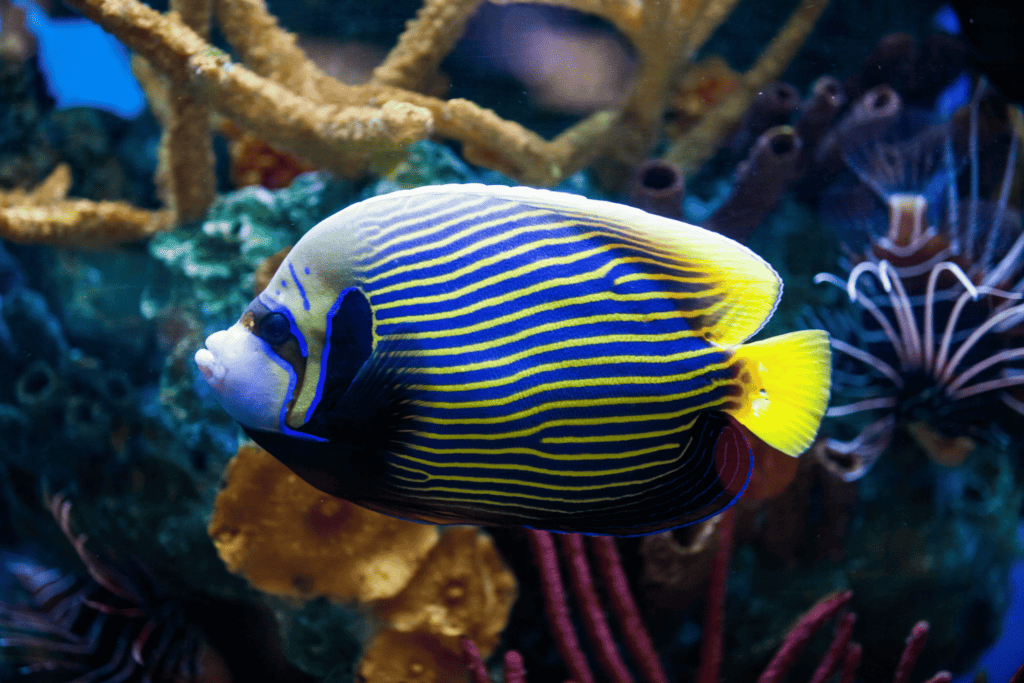
Origins and Habitat
Habitats in Different Oceans
Saltwater angelfish are found in various oceanic regions across the globe. In the Pacific Ocean, especially in the western part, they inhabit the warm tropical waters around coral reefs. The pristine environments here provide both food and shelter for these colorful creatures.
In the Atlantic Ocean, angelfish also favor coral reef habitats. The Caribbean, an area within the western Atlantic Ocean, is particularly abundant in saltwater angelfish species. These regions offer diverse living spaces and algae-rich diets for the angelfish to thrive on.
The warm waters of the Indian Ocean and the Red Sea are other places where saltwater angelfish can be found. These oceanic locations are known for their vibrant coral reef ecosystems that support a wide range of angelfish species.
Different Regions
-
Africa: Along the African coastline, saltwater angelfish are found in the Eastern parts, stretching from the South Atlantic to the Indian Ocean. The continent’s rich coral reefs serve as ideal habitats for these fish.
-
Coral Reefs: These underwater structures are considered essential for the survival of many saltwater angelfish species. Coral reefs provide a natural setting for shelter, breeding, and feeding. Angelfish can typically be found living amidst the corals, where they easily blend in with the environment.
To better understand the distribution of saltwater angelfish across different oceanic regions and habitats, consider the following table:
| Ocean | Regions | Habitat |
|---|---|---|
| Pacific Ocean | Western Pacific | Coral Reefs |
| Atlantic Ocean | Caribbean | Coral Reefs |
| Indian Ocean | Eastern Africa | Coral Reefs |
| Red Sea | – | Coral Reefs |
In conclusion, saltwater angelfish naturally inhabit a variety of oceanic locations worldwide. Their preferred habitats are the warm waters around coral reefs found in the Pacific, Atlantic, and Indian Oceans, as well as the Red Sea. By understanding the origins and habitat preferences of these extraordinary fish, we can continue to appreciate and protect their mesmerizing beauty for generations to come.
Feeding and Diet
Natural Food Sources
In the wild, saltwater angelfish predominantly feed on sponges, corals, algae, and other invertebrates. Sponges make up a significant portion of their diet, with some angelfish species consuming up to 70% of their intake from these organisms. Additionally, angelfish prey on clams, tunicates, hydroids, bryozoans, and filamentous algae. Some angelfish species also graze on macroalgae and microalgae available in their natural habitat.
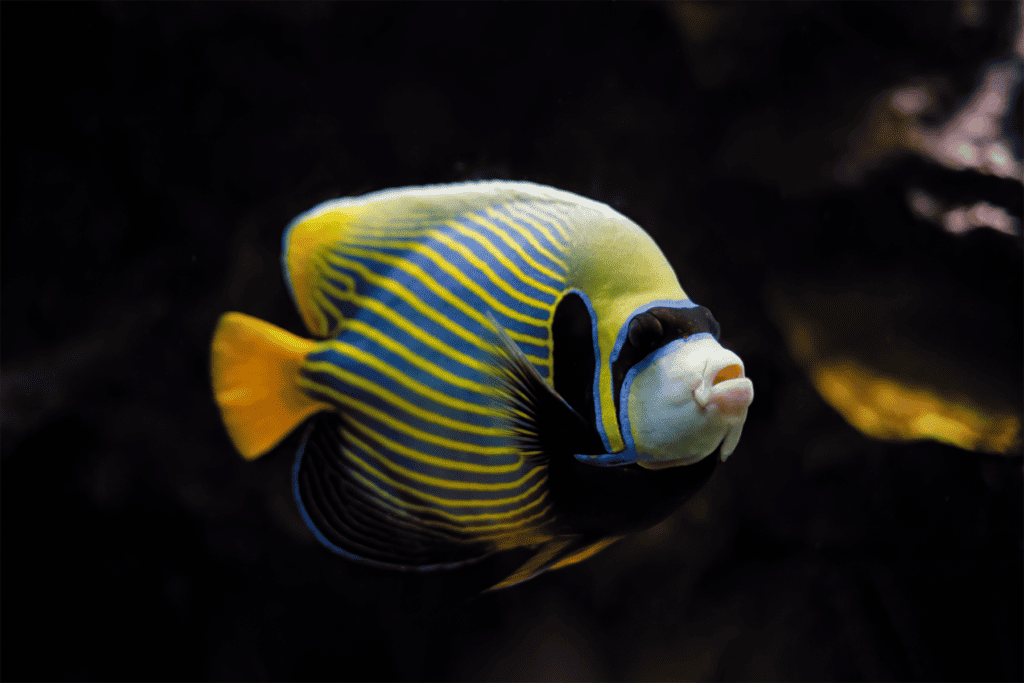
Aquarium Diet
When keeping saltwater angelfish in an aquarium, it is crucial to replicate their natural feeding habits to maintain their health. We can provide a diverse and well-balanced diet that includes:
-
Sponges: Angelfish can be fed quality marine sponge preparations, which are available at specialty aquarium stores.
-
Algae: As natural grazers, saltwater angelfish benefit from a variety of algae types. You can introduce live macroalgae, seaweed sheets, or spirulina-based flakes and pellets to their diet.
-
Live food: Supplement their diet with live foods such as brine shrimp, mysis shrimp, and copepods to encourage their natural hunting instincts.
-
Invertebrates: Incorporate a mix of frozen and thawed clams, tunicates, and other quality marine invertebrates into their feeding routine.
Feeding tips for saltwater angelfish in aquariums:
- Feed angelfish small amounts multiple times a day to mimic their natural grazing behavior.
- Adjust the quantity of food according to their needs, being mindful of overfeeding.
- Monitor their overall health and adjust the diet accordingly, ensuring they receive the necessary nutrients.
By considering the natural food sources of saltwater angelfish and incorporating a well-balanced diet, we can create a thriving environment for these beautiful creatures in our aquariums.
Popular Saltwater Angelfish Varieties
Large Angelfish
Large angelfish are a striking addition to any saltwater aquarium. They belong to the Pomacanthus, Holacanthus, and Pygoplites genera. The Emperor Angelfish (Pomacanthus imperator) is one of the most popular large angelfish, known for its vibrant colors and bold patterns. Native to the Indo-Pacific region, emperors are best suited for spacious tanks with plenty of hiding spots.
The Queen Angelfish (Holacanthus ciliaris) is another sought-after species. These graceful fish are known for their bright blue and yellow colors, and they can be found in the warm waters of the Atlantic Ocean. Like emperors, queen angelfish require ample space to swim and plenty of hiding spots.
We also recommend the French Angelfish (Pomacanthus paru) and Koran Angelfish (Pomacanthus semicirculatus) as beautiful large angelfish options for experienced aquarists.
Dwarf Angelfish
For those with smaller tanks, dwarf angelfish from the Centropyge and Genicanthus genera are ideal choices. These angelfish reach a maximum length of about 4 inches. The Flame Angelfish (Centropyge loricula), with its fiery red and orange colors, is a popular choice among aquarists. It’s native to the Central Pacific Ocean and thrives in well-established tanks with an abundance of live rock.
Other popular dwarf angelfish include:
- Regal Angelfish (Pygoplites diacanthus): Vibrant blue and yellow patterns
- Lemonpeel Angelfish (Centropyge flavissima): Bright yellow with a distinctive blue eye-ring
- Coral Beauty Angelfish (Centropyge bispinosa): Vivid blue and striking orange
- Bicolor Angelfish (Centropyge bicolor): Bold yellow and blue hues
- Cherub Angelfish (Centropyge argi): Compact size and attractive blue and orange patterns
Remember to consider the specific care requirements of each angelfish species before adding them to your aquarium. Understanding the preferences and needs of these majestic fish is essential to maintaining a thriving and harmonious marine environment.
Saltwater Angelfish Care and Maintenance
Tank Size
To ensure a healthy environment for our saltwater angelfish, we need to provide them with an appropriate tank size. A minimum of 70 gallons is suggested for a single adult angelfish, but larger tanks will allow them more space to swim and thrive. When considering a saltwater aquarium, we should also plan for compatible tankmates, which may require even larger tanks.
Care Level
Caring for saltwater angelfish is not overly complicated but does require consistent maintenance. We must maintain optimal water quality by monitoring and adjusting salinity, pH, temperature, and ammonia levels. To achieve this, we should:
- Perform regular water changes, at least every two weeks
- Test the water parameters frequently and adjust as necessary
- Use high-quality aquarium salt and marine buffers
- Choose a well-functioning filtration system
Additionally, it’s essential to provide a varied diet for our angelfish. A mix of frozen, live, and pellet foods that cater to their omnivorous nature will promote their health and longevity.
Spotting and Treating Parasites
Unfortunately, parasites can become a problem in saltwater aquariums, and angelfish are no exception. It’s crucial for us to be able to spot and treat parasites early on to prevent complications.
Some common signs of parasites in our angelfish include:
- Rapid breathing or gasping for air
- Loss of appetite
- Constant scratching against tank decorations
- Visible parasites or white spots on the body
To treat parasites in our saltwater angelfish, we can use over-the-counter parasite medications designed for saltwater fish, following the manufacturer’s guidelines. To prevent the spread of parasites, it’s important to quarantine new fish or corals before adding them to our main aquarium.
By following these care and maintenance guidelines, we can ensure that our saltwater angelfish will thrive in their aquatic environment and remain a beautiful centerpiece of our saltwater aquarium for years to come.
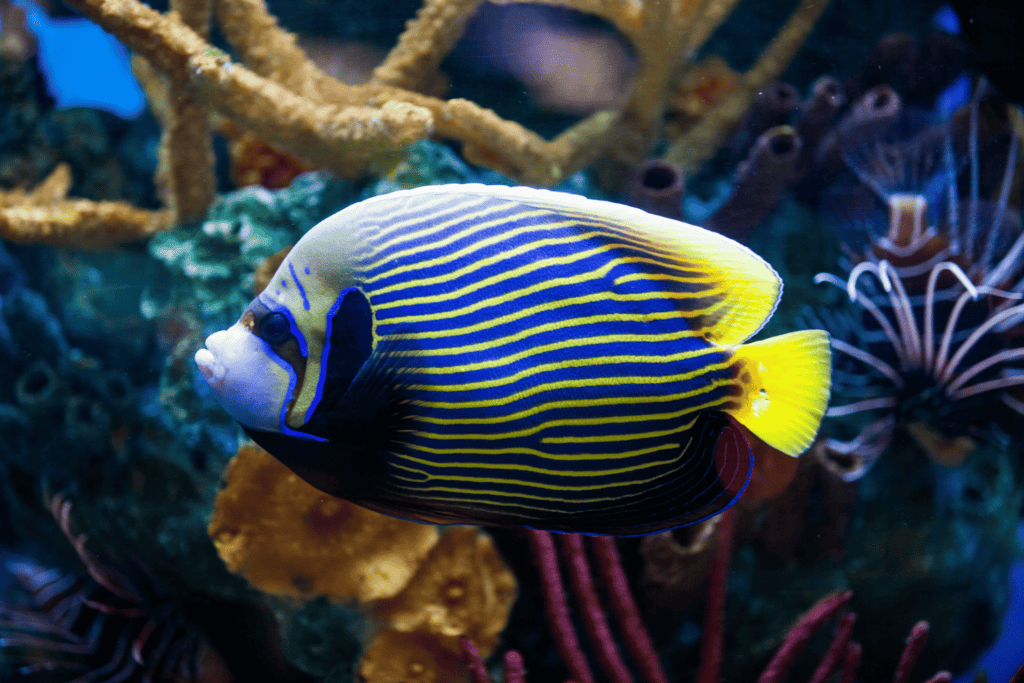
Behavior and Compatibility
Territorial Behavior
Angelfish are known for their territorial behavior. As they establish their dominance in the tank, they can become aggressive towards other tank mates. Their temperament could be classified as semi-aggressive, meaning they are not always aggressive, but they have a strong territorial presence. When we introduce new fish or rearrange the tank setup, it is essential to observe angelfish behavior closely. However, with a well-planned tank and suitable tank mates, it is possible to maintain a peaceful and harmonious environment for saltwater angelfish.
Suitable Tank Mates
For the best chance of success, we recommend choosing tank mates that have similar temperaments and compatibility with the angelfish’s personality. Some suitable tank mates for saltwater angelfish include:
- Eels: Many species of eels can coexist well with angelfish due to their non-threatening behavior and the fact that they predominantly inhabit different areas within the tank.
- Gobies: These small, colorful fish generally stay out of the angelfish’s way and can be an ideal tank mate, adding variety to the aquarium landscape.
- Groupers: Although larger than most angelfish, groupers have a generally peaceful demeanor and can share the tank territory without any conflicts.
- Butterflyfish: These beautiful and peaceful fish are typically compatible with angelfish, but it’s essential to monitor their behavior as some species may still exhibit territorial tendencies.
- Blennies: Known for their calm behavior, blennies can make excellent tank mates for angelfish as they tend to maintain their distance and avoid confrontations.
It is crucial to consider the specific needs of each fish species in our tank and adjust the environment accordingly to minimize stress and the likelihood of aggressive behavior. By offering ample hiding spots, maintaining optimal water conditions, and carefully selecting compatible tank mates, we can create a thriving ecosystem for our saltwater angelfish and their aquatic companions.
Reproduction and Lifecycle
Saltwater angelfish are known for their unique and vibrant appearances. In this section, we will discuss the reproduction and lifecycle of these fascinating creatures, focusing on their juvenile stages, adult size, and important aspects of their development.
Juvenile Stages
The juvenile phase of saltwater angelfish is an important part of their lifecycle. After hatching from their eggs, the larvae drift with ocean currents, seeking cover among plankton. Over several weeks, the fish continue to grow and metamorphose into their juvenile forms, which often differ in color and pattern from their adult counterparts. This change in appearance is thought to provide camouflage, reducing the risk of predation. As the juveniles mature, they gradually transition into their adult colors and patterns.
Adult Size
The adult size of saltwater angelfish can vary depending on the species. Sizes can range from small, such as the cherub angelfish which reach about 3 inches in length, to larger species like the queen angelfish that can grow up to 18 inches. As adults, angelfish become territorial and often form monogamous pairs or harems to defend their chosen territory.
In conclusion, understanding the saltwater angelfish’s fascinating metamorphosis from juveniles to adults, as well as their varying sizes among different species, can give us a greater appreciation for these remarkable marine creatures.
Environment and Ornamentation
When it comes to Saltwater Angelfish, we must consider the environment they live in and the ornamentation it requires. As these fish are native to reef environments, replicating their natural habitat is crucial for their well-being.
In terms of environment, it’s important to maintain appropriate water conditions for the Angelfish. The ideal temperature range is between 72°F and 78°F, with a pH level between 8.1 and 8.4. They also prefer a water flow that mimics a natural reef environment, with moderate to strong currents.
For ornamentation, having plenty of live rock for them to graze on is essential. This will provide them with food and proper hiding places. When it comes to invertebrates, some species of Saltwater Angelfish can coexist peacefully, while others may pose a threat. Therefore, it’s necessary to research individual species compatibility before introducing them into your aquarium.
Regarding soft corals, it’s important to note that not all Saltwater Angelfish are reef safe. Some species may nip at the corals, causing damage. Ensure you only include Angelfish species that are known to be reef safe in your aquarium setup.
To give you a clear idea of how to balance the environment and ornamentation, we’ll provide some examples:
- Reef Safe: Centropyge bicolor, Centropyge bispinosa, and Apolemichthys trimaculatus are examples of reef safe Angelfish that generally won’t harm invertebrates and soft corals.
- Not Reef Safe: Holacanthus ciliaris and Holacanthus clarionensis are examples of Angelfish species that may not be suitable for a coral-rich environment.
In summary, carefully considering the environment and ornamentation for your Saltwater Angelfish is crucial for their well-being. Always research and select appropriate species based on their compatibility with the invertebrates, soft corals, and the overall setup of your aquarium to ensure a thriving ecosystem.
Potential Concerns
Saltwater vs Freshwater
Angelfish are popular among fish enthusiasts, but it is important to recognize the difference between saltwater and freshwater angelfish. While both types are visually stunning, their requirements and care differ significantly. The main distinction is that saltwater angelfish require the precise maintenance of salinity levels in their tanks. Conversely, freshwater angelfish can thrive in a wider range of water conditions.
Wild-caught saltwater angelfish tend to be more sensitive to water parameters and can be challenging to acclimatize to a closed aquarium system. Due to this fragility, we recommend researching and preparing carefully before introducing a saltwater angelfish into a tank.
Caution for Beginners
Saltwater angelfish are not recommended for beginners due to their specific care requirements. Inappropriate salinity levels can harm these delicate creatures. To measure and maintain the correct salinity, you’ll need:
- A reliable salinity testing kit
- Salt mix or marine aquarium salt
- A hydrometer or refractometer
| Item | Purpose |
|---|---|
| Salinity testing kit | Monitor the salt levels in the aquarium accurately |
| Salt mix | Adjust the salt concentration in the water |
| Hydrometer | Measure the specific gravity of the water (related to salinity) |
In addition to salinity, other crucial factors contribute to the health of saltwater angelfish, such as water temperature, pH levels, and the cycling of beneficial bacteria in the aquarium. Beginners should consider starting with a freshwater angelfish, as they are generally more tolerant of varying water conditions and different types of fish tankmates.
In conclusion, saltwater angelfish indeed are beautiful and unique species, but their care requires a level of expertise and dedication that surpasses that of their freshwater counterparts. For those new to the world of fishkeeping, our advice is to explore freshwater angelfish first before venturing into the world of saltwater varieties.
Frequently Asked Questions
What is the average cost of Saltwater Angelfish?
The average cost of Saltwater Angelfish varies depending on the species, size, and overall health of the fish. Generally speaking, prices can range from $20 to $200 or more for rare and exotic species. Keep in mind that this is an estimated range and prices can differ based on local availability and demand.
Are Saltwater Angelfish suitable for reef aquariums?
Many Saltwater Angelfish species can adapt well to reef aquariums, as they typically inhabit coral-rich environments in the wild. However, some species have been known to nip at corals and other invertebrates. We recommend researching the specific species you’re interested in adding to your reef tank to ensure compatibility.
Which Saltwater Angelfish species are easiest to keep?
While all Saltwater Angelfish require a certain level of care, some species are easier to keep for beginner aquarists. Examples of hardy species include the Coral Beauty, Flame Angel, and the Bicolor Angelfish. These species tend to be more adaptable to varying water conditions and have less specific dietary requirements.
What are the most visually striking Saltwater Angelfish?
Saltwater Angelfish are known for their vibrant colors and patterns. Some of the most visually striking species include the Regal Angelfish, Queen Angelfish, Emperor Angelfish, and the French Angelfish. These species are often sought after by aquarists due to their unique and captivating appearance.
How big do various Saltwater Angelfish species grow?
Saltwater Angelfish species vary in size, with some remaining relatively small at around 3-4 inches, while others can grow up to 14-16 inches in length. For example, the Coral Beauty and Flame Angel stay on the smaller side, whereas the Queen Angelfish and the Emperor Angel tend to grow larger. We recommend researching the specific species you’re interested in to determine if your aquarium can accommodate their adult size.
Which Saltwater Angelfish are known for their aggressive behavior?
Saltwater Angelfish have varying temperaments, with some species being more aggressive than others. Aggressive species like the Emperor Angelfish and the Koran Angelfish are known to be territorial and may compete for resources. Monitoring tank compatibility and providing ample space and hiding spots can help mitigate potential conflicts caused by aggressive Angelfish.
